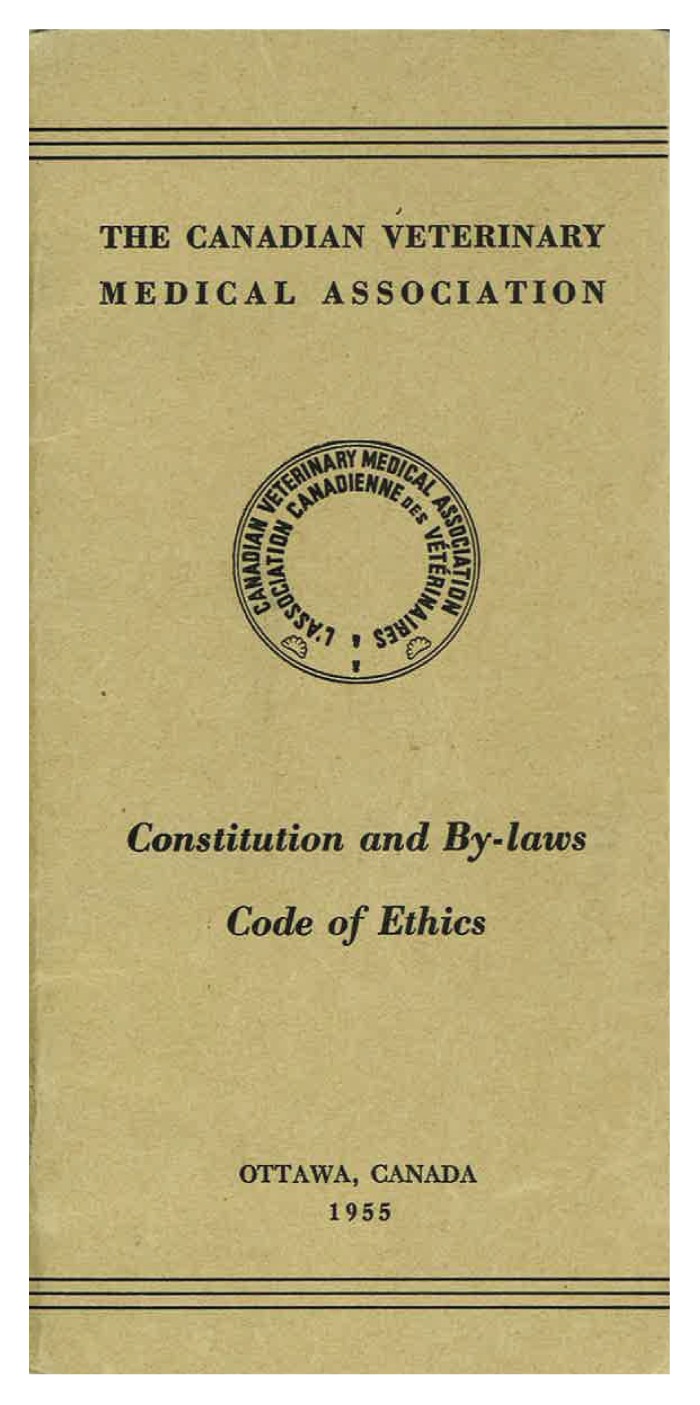
Veterinary Oath —
“As a member of the veterinary medical profession, I solemnly swear that I will use my scientific knowledge and skills for the benefit of society.
I will strive to promote animal health and welfare, relieve animal suffering, protect the health of the public and environment, and advance comparative medical knowledge.
I will practice my profession conscientiously, with dignity, and in keeping with the principles of veterinary medical ethics.
I will strive continuously to improve my professional knowledge and competence and to maintain the highest professional and ethical standards for myself and the profession.”
CVMA 2004
The Veterinary Oath states “I will practice my profession conscientiously, with dignity, and in keeping with the principles of veterinary medical ethics.” Did you know that up until recently the CVMA did not have a document outlining these principles of veterinary medical ethics? The fact that Canada did not have an updated Code of Ethics to reference was a concern for the CVMA Council so it worked to update and approve a new veterinary code of ethics document. The new document is called “Principles of Veterinary Medical Ethics of the CVMA.” I would like to highlight some of the important changes within the new document and discuss some of the interesting history in developing our new Principles of Veterinary Medical Ethics.
During the developmental research, a 1955 copy of the Bylaws and Code of Ethics of the CVMA was found. It can be assumed that at some point after 1955, the Association Bylaws were updated and the Code of Ethics was removed and not replaced. This left us as the only national veterinary association without a Code of Ethics. In this 1955 document it stated that all veterinarians must conduct themselves as gentlemen; it was obvious that the document needed an update. It was so outdated a new document had to be developed from scratch. Dr. Barb Horney and I researched the American, British, and Australian Veterinary Medical Associations’, and the Federation of Veterinarians of Europe current Codes of Veterinary Ethics documents; not surprisingly all of those associations’ principles are similar.

The new Principles of Veterinary Medical Ethics is laid out according to general principles, veterinary responsibilities to animals, clients, the public, the veterinary team, and finally to the veterinarians themselves. Historically, the CVMA and the American Veterinary Medical Association (AVMA) Code of Ethics have been similar throughout the development of the associations. In fact, the AVMA Code was worded and organized similar to our 1955 Code, which predated the AVMA code. Clearly, our 2 associations have a long history of collaboration and sharing. The AVMA just recently updated their Code and included an important clause about discrimination. The CVMA Council has added this clause to our Principles as well. Council is also going to ensure that our Principles are reviewed more often to keep them as current as possible.
It was important for Council to have this document focus on Principles. After consultation with the provincial regulatory bodies it was apparent that we needed to ensure that veterinarians did not confuse these Principles with the Codes of the regulatory authorities of the provinces. Each province has a Code of Conduct within their acts or Bylaws that veterinarians in that province must follow and the regulatory bodies enforce. In updating the Principles (the name was changed to Principles from Code), much of the “regulatory language” was removed and we made sure that the Principles did not conflict with provincial regulatory Codes. The Principles are not enforceable, but may be used as a guide by the provincial regulating bodies. The Canadian Veterinary Oath is also not enforceable, but in my opinion it is more important than any provincial regulation. I strongly believe the profession of veterinary medicine should determine its own ethical standards. The CVMA needed this document. Regardless of enforcement, when anyone asks, “What are the ethical standards of the profession?” we can now say we have a document outlining them.
Those who teach our future veterinarians really need these Principles. Every veterinary student has to learn about ethics and jurisprudence in veterinary school. Educators were encouraging the CVMA to have an updated document. Unfortunately until now when students asked for the Principles the response was Canada doesn’t have any, but here are the AVMA ones. The student population of the Canadian veterinary community will benefit greatly from an updated set of Principles. As the president of the CVMA I have had the privilege of being able to meet many veterinarians, practicing locally, nationally, and globally. I recently attended the white coat ceremony of the University of Calgary Veterinary Medicine class of 2020. The students stood and recited the Veterinary Oath. As indicated above, the Oath states that a veterinarian in Canada will follow the principles of veterinary medical ethics. The ironic issue being that the old Code of Ethics was almost laughable. The veterinary schools of Canada needed a document that they could present to students as a guide to their practice. They can now recite our Oath knowing what is meant by veterinary medical ethics.
The new set of Principles brings a much needed guide to veterinarians of Canada; new, old, and future veterinarians. I would like to acknowledge the hard work by Dr. Barb Horney for getting these Principles finalized and by Dr. Jack Wilson for adding important content and pressuring us to get the job done. The new Principles of Veterinary Medical Ethics of the CVMA will be available to members this fall; an announcement will be made wthin The CVJ. Please stay tuned.
Footnotes
Use of this article is limited to a single copy for personal study. Anyone interested in obtaining reprints should contact the CVMA office (hbroughton@cvma-acmv.org) for additional copies or permission to use this material elsewhere.


